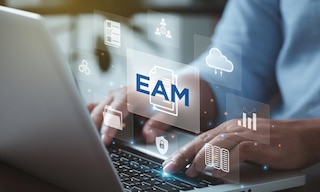
What is EAM software?
Overseeing tools, employees, and other assets is essential to ensure the smooth operation of your business and raise productivity. Enterprise asset management software — i.e., EAM software — can support you in this mission, offering multiple applications across various industries.
What is EAM?
EAM combines software, systems, and services to maintain and supervise a company’s equipment and assets. Its chief purpose is to extend the quality and usage of these assets throughout their life cycle while reducing operating costs. It covers all stages, including asset capital planning, procurement, installation, performance, maintenance, and disposal.
Why do we need EAM?
All organizations — regardless of size — possess assets. For large corporations, these assets constitute the thousands of puzzle pieces that make up the company. EAM helps monitor, evaluate, and optimize these elements, which could be vehicles, materials, or buildings. EAM provides numerous advantages:
- Information centralization. Maintenance supervisors know the asset’s location, requirements, assigned personnel, and the duration of work. Typically, the technology for the EAM strategy is integrated into a computerized maintenance management system, which automates these processes.
- Application consolidation. EAM software consolidates the management of virtually any asset within your company.
- Infrastructure and obsolescence management. Having more information to execute maintenance tasks and assess risks extends asset life cycles and boosts return on investment (ROI).
- Asset maximization. Collecting data through Internet of Things (IoT) sensors and devices or analytical tools increases equipment availability and reliability.
- Safety improvements. Artificial intelligence (AI), analytics, and IoT simplify the task of ensuring compliance with environmental and occupational health and safety requirements.
- Predictive maintenance. EAM software prevents problems before they happen, avoiding production downtime.
- Remote monitoring. An EAM system consolidates information from different departments and sources to provide more accurate alerts and decision-making support.

How do you implement EAM successfully?
There are several best practices for EAM strategies to maximize their effectiveness. However, they can be further enhanced with EAM software. Optimal asset management considers these aspects:
- Analysis. Obtain as much information as you can on operations to automate specific tasks.
- Maintenance. Proper asset management makes corrective maintenance — repairing breakdowns and conducting preventive inspections — a thing of the past. Instead, you can perform predictive maintenance when the data indicate anomalies.
- Planning. With orders and plans represented visually through diagrams, it becomes easier to prioritize certain tasks.
- Records. Collect data relating to jobs, from initial request to completion.
- Safety. Documenting incidents lets you analyze them and implement corrective measures.
- Traceability. Meter or barcode reading and RFID solutions are other ways you can gather information.
- Supply chain visibility. Incorporating IoT technology helps integrate EAM software with supply chain management systems.
Sectors like intralogistics employ warehouse management systems (WMSs) with specific functions for these tasks. This software provides detailed information on goods inflows/outflows and order status. Moreover, it maintains product traceability across the entire journey.
EAM applications in industry
EAM software can benefit multiple sectors in a variety of ways:
- Energy and utilities. When distributing water, gas, and electricity, assets such as pipelines and power lines are used. Managing personnel scheduling and remote equipment information is complex.
- Manufacturing. Asset management is highly valuable in diverse sectors such as automotive, aerospace, defense, electronics, and industrial and consumer product manufacturing.
- Mining and petrochemistry. In these fields, it’s vital to have detailed information on asset status and workflows and to comply strictly with health and safety regulations.
- Healthcare. EAM software enables professionals to track, locate, and prepare critical assets, ensure the proper condition of facilities, and generate reports.
- Transportation. Comprehensive information about assets and their inventory facilitates effective logistics operations. This extends to driver records, spare parts, delivery schedules, fuel availability, and more.

What is EAM software?
EAM software tracks and analyzes the costs and performance of a company’s assets throughout their life cycle. It provides a centralized view of all equipment, encompassing repair histories, audits, and purchase orders. This consolidation helps each part of the business to be in sync with the rest.
Through remote monitoring driven by AI in logistics and advanced tracking, managers can make better decisions.
How does EAM software work?
Although these programs used to be installed on-premise, technology allows for them to be cloud-based. This is extremely useful for linking an EAM with other management systems, such as a WMS. These are the key steps to follow in EAM:
- Migrate assets to the cloud. Having a centralized data repository makes it possible to use analytics and retrieve strategic information.
- Employ data to optimize productivity. Machine learning, digital twins, and predictive analytics enable you to carry out predictive maintenance, thus maximizing asset availability.
- Schedule inspections proactively. Detect, report, and resolve incidents quickly, prioritizing the most critical to minimize inactivity.
- Manage assets and fieldwork. Track work orders from anywhere.
Are you looking to gain full control over your warehouse operations? It’s best to empower yourself with data on your logistics operations to raise your productivity. So, be sure to contact us. At Interlake Mecalux, we’re experts in intralogistics solutions. Our Easy WMS software — developed by a team of more than 400 engineers — reduces logistics costs and errors while enhancing the operation of production and distribution centers.
